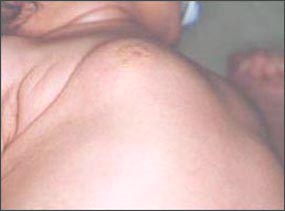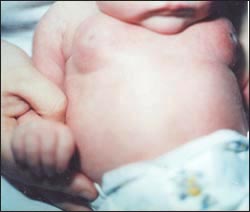남아에게 생긴 여성형 유방증, Gynecomastia
남아에게 생기는 여성형 유방증의 원인
- 자궁 속 태아는 모체로부터 에스트로겐 등 여러 종류의 호르몬을 공급받는다.
- 태아가 모체로부터 공급받았던 모체의 성호르몬으로 신생 남아들의 한쪽 유방 또는 양쪽 유방이 일시적으로 정상 이상으로 커질 수 있다.
- 이렇게 커진 신생 남아 유방은 생후 3~4주 지나면 거의 정상 크기로 돌아가는 것이 보통이다.
- 말기 학령기 남아들에게 사춘기가 시작될 때 남아 신체 내에서 분비되는 에스트라디올 여성 호르몬과 남성호르몬 테스토스테론(Testosterone) 호르몬의 영향으로 남아의 한쪽 또는 양쪽 유방이 여성형 유방 비스름하게 발육 될 수 있다.
- 이렇게 남아들에게 사춘기가 올 때 생긴 여성형 유방을 청소년기 여성형 유방 또는 여성형 유방이라 한다.
- 사춘기 기간 동안 사춘기 남아들의 40~70%에게 청소년기 여성형 유방이 생긴다.
- 청소년기 여성형 유방은 치료를 하지 않아도 생긴 후 2년 이내에 75%가, 3년 이내에 90%가 없어진다.
- 어떤 남아들의 유방은 다른 남아들의 유방보다 자신의 체내에서 분비되는 여성 호르몬의 영향에 더 예민하게 반응할 수 있고, 어떤 남아들의 유방은 자신의 체내에서 분비되는 미량의 여성 호르몬에 과민하게 자극 받아 조기에 유방이 발육된다.
- 여성 호르몬 약물을 경구로 섭취하거나 피부에 바르거나, 고환 종양이나 부신 종양이 날 때, 선천성으로 남아들의 유방이 조기 발육될 수 있다.

그림 1-33. 병이 없는 신생아의 유방이 조기발육됐다. 출생 전 모체로부터 받은 여성호르몬으로 인해 생긴다.
Copyright ⓒ 2011 John Sangwon Lee, MD., FAAP

그림 1-32. 병이 없는 신생아의 유방이 조기발육됐다. 출생 전 모체로부터 받은 여성호르몬으로 인해 생긴다.
Copyright ⓒ 2011 John Sangwon Lee, MD., FAAP
남아에게 생기는 여성형 유방증의 증상 징후 진단
- 사춘기 남아들의 40~70%에서 한쪽 유방이나 양쪽 유방이 정상적으로 조금 더 커지면서 여성형 유방이 생길 수 있다.
- 여성형 유방이 처음 얼마동안 은근히 조금 아플 수 있다. 그 후 2개월~ 2년 동안 별다른 증상 징후가 없이 유방만 커져 있을 수 있다.
- 처음 얼마동안 커졌던 상태 그대로 몇 년 동안 계속 있다가 그 후 성인 남성들의 정상적 유방으로 성장 발육되는 것이 보통이다.
- 사춘기 남아들의 유방이 비정상적으로 커져도 젖꼭지는 성인 여성의 젖꼭지 같이 발육되지도 않고 여성형 유륜(유두륜)은 생기지 않는다.
- 드물게, 남아들의 유방이 성인 여성 유방의 크기만큼 비정상적으로 커질 수 있다.
- 이런 유형의 유방이 있는 사춘기 남아는 남들 앞에서 옷 벗기를 싫어하고 정신적 스트레스를 많이 받을 수 있다.
- 병력·증상 징후·진찰소견 등을 종합해서 진단한다.
남아에게 생기는 여성형 유방증의 치료
- 유방 조기 발육으로 커진 신생아의 여성형 유방은 아무 치료 없이 관찰한다.
- 사춘기 남아들의 한쪽이나 양쪽 유방에 여성형 유방이 생겨 많이 고민할 때는 유방 성형수술 치료를 받을 수 있다.
- 사춘기가 시작될 때 한쪽 유방이나 양쪽 유방이 조금 커지면서 아프면 관찰적 치료를 한다.
- 비만한 남아들의 유방이 여성형 유방처럼 클 수 있지만 젖꼭지는 성인 여성들의 젖꼭지처럼 커지지 않는다.
- 비만증을 치료하면 커진 유방이 정상적으로 돌아간다.
- 다른 원인으로 유방이 비정상적으로 커졌을 때는 그 원인에 따라 치료한다.
Gynecomastia in boys
Causes of gynecomastia in boys
• The fetus in the womb receives various hormones, including estrogen, from the mother.
• One or both breasts of newborn boys may be temporarily enlarged beyond normal due to maternal sex hormones supplied by the fetus from the mother.
• It is normal for newborn boys’ breasts to return to their normal size after 3 to 4 weeks after birth.
• In late school-age boys, estradiol and testosterone, which are secreted in the body at the beginning of puberty, may cause one or both breasts of boys to develop obliquely gynecomastia.
• Gynecomastia that occurs when boys reach puberty is called adolescent gynecomastia or gynecomastia.
• During puberty, 40-70% of adolescent boys develop adolescent gynecomastia.
• Adolescent gynecomastia disappears 75% within 2 years and 90% within 3 years without treatment.
• Some boys’ breasts may respond more sensitively to the effects of female hormones secreted by their body than other boys’ breasts, and some boys’ breasts are overstimulated by trace amounts of female hormones secreted by their body. Breasts develop early.
• When female hormonal drugs are taken orally or applied to the skin, or when a testicular or adrenal tumor develops, it is congenital that boys’ breasts may develop prematurely.

Figure 1-33. Breasts of infants without disease developed prematurely. It is caused by female hormones received from the mother before birth. Copyright ⓒ 2011 John Sangwon Lee, MD., FAAP

Figure 1-32. Breasts of infants without disease developed prematurely. It is caused by female hormones received from the mother before birth. Copyright ⓒ 2011 John Sangwon Lee, MD., FAAP
Diagnosis, signs, symptoms of gynecomastia in boys
• In 40-70% of adolescent boys, gynecomastia may develop as one or both breasts normally grow slightly larger.
• Gynecomastia can be mildly painful during the first few days. After that, for 2 months to 2 years, there may be no symptoms and only the breasts may be enlarged.
• It is normal for the breasts to grow and develop into normal adult male breasts after continuing for several years as they initially grew.
• Even when the breasts of adolescent boys grow abnormally, the nipples do not develop like adult female nipples, and gynecomastia (areola) does not occur.
• Rarely, a boy’s breast can become abnormally large as an adult female’s breast.
• Adolescent boys with this type of breast are reluctant to take off their clothes in front of others and can be emotionally stressed.
• Diagnosis is made by combining medical history, symptoms, signs, and examination findings.
Treatment of gynecomastia in boys
• Gynecomastia in newborns who have enlarged due to premature breast development should be observed without any treatment.
• When adolescent boys have gynecomastia on one or both breasts and are very worried, they can receive plastic surgery treatment.
• At the onset of puberty, if one or both breasts become slightly enlarged and painful, observe treatment.
• Although obese boys’ breasts can be as large as gynecomastia, their nipples do not grow as large as adult women’s nipples.
• When obesity is treated, enlarged breasts return to normal.
• If the breast is abnormally enlarged due to other causes, treat it according to the cause.
출처 및 참조 문헌 Sources and references
- NelsonTextbook of Pediatrics 22ND Ed
- The Harriet Lane Handbook 22ND Ed
- Growth and development of the children
- Red Book 32nd Ed 2021-2024
- Neonatal Resuscitation, American Academy Pediatrics
- www.drleepediatrics.com 제1권 소아청소년 응급 의료
- www.drleepediatrics.com 제2권 소아청소년 예방
- www.drleepediatrics.com 제3권 소아청소년 성장 발육 육아
- www.drleepediatrics.com 제4권 모유,모유수유, 이유
- www.drleepediatrics.com 제5권 인공영양, 우유, 이유식, 비타민, 미네랄, 단백질, 탄수화물, 지방
- www.drleepediatrics.com 제6권 신생아 성장 발육 육아 질병
- www.drleepediatrics.com제7권 소아청소년 감염병
- www.drleepediatrics.com제8권 소아청소년 호흡기 질환
- www.drleepediatrics.com제9권 소아청소년 소화기 질환
- www.drleepediatrics.com제10권. 소아청소년 신장 비뇨 생식기 질환
- www.drleepediatrics.com제11권. 소아청소년 심장 혈관계 질환
- www.drleepediatrics.com제12권. 소아청소년 신경 정신 질환, 행동 수면 문제
- www.drleepediatrics.com제13권. 소아청소년 혈액, 림프, 종양 질환
- www.drleepediatrics.com제14권. 소아청소년 내분비, 유전, 염색체, 대사, 희귀병
- www.drleepediatrics.com제15권. 소아청소년 알레르기, 자가 면역질환
- www.drleepediatrics.com제16권. 소아청소년 정형외과 질환
- www.drleepediatrics.com제17권. 소아청소년 피부 질환
- www.drleepediatrics.com제18권. 소아청소년 이비인후(귀 코 인두 후두) 질환
- www.drleepediatrics.com제19권. 소아청소년 안과 (눈)질환
- www.drleepediatrics.com 제20권 소아청소년 이 (치아)질환
- www.drleepediatrics.com 제21권 소아청소년 가정 학교 간호
- www.drleepediatrics.com 제22권 아들 딸 이렇게 사랑해 키우세요
- www.drleepediatrics.com 제23권 사춘기 아이들의 성장 발육 질병
- www.drleepediatrics.com 제24권 소아청소년 성교육
- www.drleepediatrics.com 제25권 임신, 분만, 출산, 신생아 돌보기
- Red book 29th-31st edition 2021
- Nelson Text Book of Pediatrics 19th- 21st Edition
- The Johns Hopkins Hospital, The Harriet Lane Handbook, 22nd edition
- 응급환자관리 정담미디어
- Pediatric Nutritional Handbook American Academy of Pediatrics
- 소아가정간호백과–부모도 반의사가 되어야 한다, 이상원 저
- The pregnancy Bible. By Joan stone, MD. Keith Eddleman, MD
- Neonatology Jeffrey J. Pomerance, C. Joan Richardson
- Preparation for Birth. Beverly Savage and Dianna Smith
- 임신에서 신생아 돌보기까지. 이상원
- Breastfeeding. by Ruth Lawrence and Robert Lawrence
- Sources and references on Growth, Development, Cares, and Diseases of Newborn Infants
- Emergency Medical Service for Children, By Ross Lab. May 1989. p.10
- Emergency care, Harvey Grant and Robert Murray
- Emergency Care Transportation of Sick and Injured American Academy of Orthopaedic Surgeons
- Emergency Pediatrics A Guide to Ambulatory Care, Roger M. Barkin, Peter Rosen
- Quick Reference To Pediatric Emergencies, Delmer J. Pascoe, M.D., Moses Grossman, M.D. with 26 contributors
- Neonatal resuscitation Ameican academy of pediatrics
- Pediatric Nutritional Handbook American Academy of Pediatrics
- Pediatric Resuscitation Pediatric Clinics of North America, Stephen M. Schexnayder, M.D.
-
Pediatric Critical Care, Pediatric Clinics of North America, James P. Orlowski, M.D.
-
Preparation for Birth. Beverly Savage and Dianna Smith
-
Infectious disease of children, Saul Krugman, Samuel L Katz, Ann A.
- 제4권 모유, 모유수유, 이유 참조문헌 및 출처
- 제5권 인공영양, 우유, 이유, 비타민, 단백질, 지방 탄수 화물 참조문헌 및 출처
- 제6권 신생아 성장발육 양호 질병 참조문헌 및 출처
- 소아과학 대한교과서
Copyright ⓒ 2014 John Sangwon Lee, MD., FAAP
“부모도 반의사가 되어야 한다”-내용은 여러분들의 의사로부터 얻은 정보와 진료를 대신할 수 없습니다.
“The information contained in this publication should not be used as a substitute for the medical care and advice of your doctor. There may be variations in treatment that your doctor may recommend based on individual facts and circumstances.
“Parental education is the best medicine.